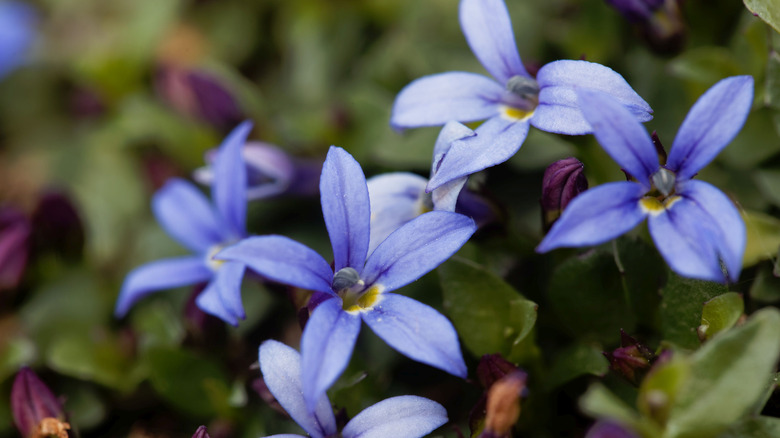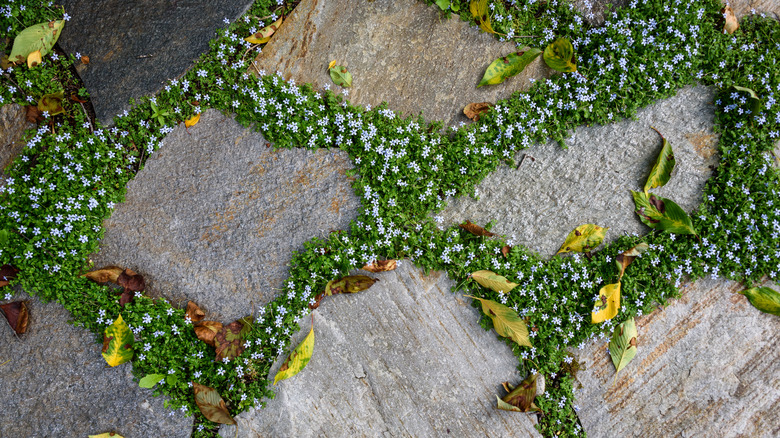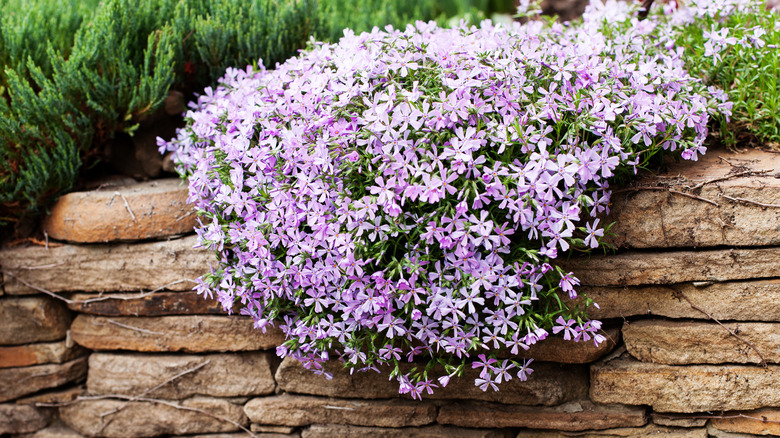The Downsides Of Choosing Blue Star Creeper As A Grass Alternative For Your Yard
Imagine what you could do with 66 extra hours. You could take a trip, start a new hobby, or finally organize your closet. According to the 2022 American Time Use Survey by the Bureau of Labor Statistics, the average American spends roughly 66 hours per year on lawn and garden care. Since there are nearly 40 million acres of turf grass in the United States, it's likely that much of this time is spent mowing, watering, and otherwise maintaining grass lawns. When you combine these lost hours with costly water bills, it's not surprising that many people are replacing their grass yards with low-upkeep, water-saving ground covers like blue star creeper (Isotoma fluviatilis). While this hardy plant ranks high on the list of bestselling ground covers, its aggressive growing habits can make it feel less like a low-maintenance grass alternative and more like a high-maintenance hassle.
Native to Australia, blue star creeper is a low-growing evergreen perennial with small green leaves and blue, star-shaped flowers that bloom throughout the spring and summer. It grows well in a variety of soil types and sun exposures. This versatility makes blue star creeper a popular choice for growing in rock gardens and under trees. These plants also withstand moderate to heavy foot traffic, so they're excellent for filling spaces between stepping stones. As its name implies, blue star creeper spreads easily ... maybe a bit too easily. You'll need to stay vigilant and take preventative measures to keep these burgeoning beauties from taking over your yard.
The downsides of blue star creeper
A blanket of blue flowers creates a serene landscape — unless the blanket starts smothering the other plants in your yard. Blue star creeper spreads by modified underground stems called rhizomes that send out shoots and leaves that develop into new plants. Because of their extensive underground root system, the plants tend to pop up in unexpected places, sometimes many feet away from their original location. It's best to dig up these interlopers as soon as you spot them. If left unchecked, blue star creeper can swiftly swallow up neighboring perennials and grasses. On the plus side, it also suppresses pesky weeds.
If you love the look of blue star creeper but don't want it running rampant, there are a few ways you can keep these proliferating plants in check. For instance, burying deep landscape edging around the perimeter of the plants can inhibit invasions into unintended areas by blocking the branching rhizomes. Another clever way to keep plants from spreading is to place them in large plastic pots before burying them in the ground. Just make sure there are plenty of holes in the bottom of the pot to allow for drainage. While they're predominantly used as ground covers, blue star creeper's trailing flowers make them a perfect choice for hanging baskets. They also look great when spilling over the edges of mixed containers. Try planting them with taller perennials for a striking layered look.
Less aggressive alternatives to blue star creeper
For many people, blue star creeper's beautiful blooms outweigh the risks of its aggressive growing habits. However, there are other ground cover plants you can grow in your yard that require less vigilance. Thyme-leaf speedwell (Veronica oltensis) is a hardy evergreen that thrives in many locations. Native to Turkey, this adaptable plant has dark green, lacy-like leaves and produces hundreds of sky blue to deep blue flowers in spring and early summer. It's a great choice for filling in cracks between flagstone or pavers, and it withstands moderate foot traffic. Like blue star creeper, thyme-leaf speedwell is drought tolerant and works well in rock gardens and planters. But because it grows slowly, it's not the best choice for covering huge swaths of soil.
Moss phlox (Phlox subulata) is another flowering ground cover that is native to some eastern and central regions of the U.S. This low-growing evergreen has needle-like leaves that form cushiony, moss-like mats. Moss phlox blooms in mid to late spring, producing a carpet of pink and violet flowers. Some cultivated varieties also produce blue flowers. Moss phlox is moderately drought tolerant and works well in rock gardens and between pavers, although it's less tolerant of foot traffic. Regardless of which ground cover you choose, low-maintenance grass alternatives can free you from endless mowing and watering. Better start planning what you will do with all that extra time.


